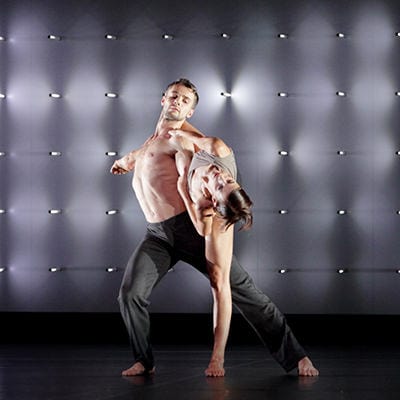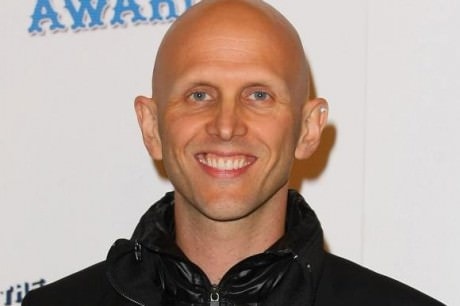The curtain rises on a dark stage, lit only by torches held by four dancers at the four corners of the stage, surrounding two dancers prancing and weaving about in coordinated, syncopated step. One by one, the torchbearers walk off the stage—leaving only darkness. In the distance, the twinkle of small lights becomes visible, growing brighter as the music—an eccentric type of whirring and whistling—reaches a climax.

The curtain of lights rises, and, from behind, dancers emerge solo and in pairs—some moving fluidly across the stage as one might imagine in traditional ballet, others jolting, squirming, and gyrating about as if possessed by some other-worldly force.
This is the opening sequence to the hour-long modern dance spectacle FAR, presented by Wayne McGregor Random Dance.
The Kennedy Center bills FAR as a piece that was “inspired by the controversial Age of Enlightenment,” mining an era that first placed “a body in question.” The ten incredible dancers (Catarina Carvalho, Travis Clausen-Knight, Travis Clausen-Knight, Michael-John Harper, Louis McMiller, Daniela Neugebauer, Anna Nowak, James Pett, Fukiko Takase, and Jessica Wright) “confront the distortions, sensuality, and feeling of the 18th century’s searing contemporary sensibility.”
At the center of FAR’s artistic vision is multi award-winning British choreographer Wayne McGregor—who serves as the Artistic Director and Choreographer of the performance. McGregor’s work was last seen at The Kennedy Center on Alvin Ailey American Dance Theater in 2014 when they danced Chroma, the 2006 Olivier Award for Best New Dance Production.
FAR is a visual and audio smorgasbord. With a computerized pin board of 3,200 LED lights, the lights dance in syncopated rhythm to the steps of the dancers, creating an immersive experience that is so meticulously synchronized that the lighting design almost becomes a performer itself. At times, the LED lights, which are mounted on movable pegs in the board, simulate flashes of lightning. At other times, they blend fluidly with one another to emulate the movement of water or wind. Yet, at other times still, the lights are used as a timer—pulsating with the music to give the sense of time passing. The lighting display is a visual masterpiece and is one of many reasons I would recommend checking this performance out before it closes on Saturday.
The score by Ben Frost is similarly magical. While there are more traditional lyrical pieces incorporated in the medley, what’s most jarring about the score is how haunting it is. It seems as though Frost wanted to include some of the more frightening elements of our psyche in the score—building tiger roars, screeching, white noise, and booming explosions into the experience to excite our imaginations and create a fully immersive experience. The experience and integration is seamless, and music helps to explain the action on stage in an otherwise continuous hour-long performance. These audial cues help to punctuate each scene, and, thus, serve a functional as well as a stylistic purpose.
It’s difficult to tell the dancers apart in this piece—which may be the intended purpose—but there were nonetheless standout performances. Fukiko Takase—who is easily identifiable because of her long hair which whips in the wind as she turns about the stage—performed a fairylike solo in the earlier part of the performance that was forceful yet simultaneously lyrical. Louis McMiller was similarly outstanding as his pieces were a bit sharper than the rest, emulating a style that might be analogous to modern day hip-hop.

The best moments were when the company danced in sync. In one piece, which was choreographed to tribalistic thumping and the roars of animals, showed how synchronized this company is even through choreographed chaos. While groups of company members performed bits of choreography in isolated corners of the stage (as if like animals herding or traveling in packs), there were moments of synchronization where the audience could literally hear the stepping and stomping in rhythm—creating a breathtaking sense of coherence despite aberrant chaos.
Founded in 1992, “Wayne McGregor | Random Dance” became the instrument upon which the award-winning McGregor evolved his drastically fast and articulate choreographic style. The company reflects his innovative approach to new technology and incorporating animation, digital film, 3D architecture, electronic sound, and virtual dancers into the live choreography.
It’s no surprise that The New York Times bills McGregor as someone who is “doing some of the most exciting work in ballet on the planet,” calling FAR “impressive… [with] so much to marvel at.”
Running Time: One hour, with no intermission.
Wayne McGregor Random Dance plays through Saturday, May 3, 2014 at The Kennedy Center’s Eisenhower Theater – 2700 F St NW, in Washington, DC. Purchase tickets online, by phone at (202) 467-4600, or at The Kennedy Center box office.




